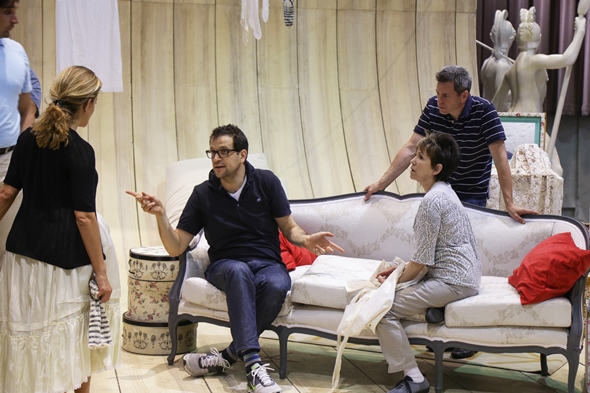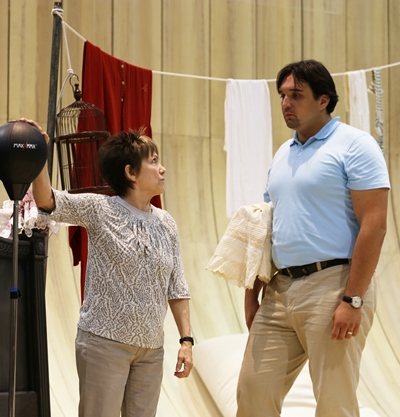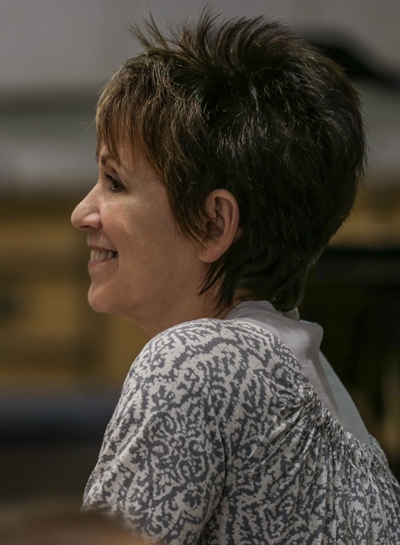Shakespeare director Barbara Gaines modulates to Mozart at Lyric Opera, and sees second Bard
 Interview: Directing “The Marriage of Figaro” as her first dip into Mozart, Gaines finds Shakespeare the humanist reflected in a bittersweet opera. Curtain up Sept. 26. The production runs through Oct. 24.
Interview: Directing “The Marriage of Figaro” as her first dip into Mozart, Gaines finds Shakespeare the humanist reflected in a bittersweet opera. Curtain up Sept. 26. The production runs through Oct. 24.
By Lawrence B. Johnson
The first venture for the Lyric Opera of Chicago this season is also the first Mozart ever taken on by Barbara Gaines, artistic director at Chicago Shakespeare Theater. And in the poignancy – and the comedy – of “The Marriage of Figaro,” Gaines finds the Bard’s own sensibility, his empathy and his compassion.
 “What Shakespeare did with words, Mozart achieved with notes – and ‘The Marriage of Figaro’ is note perfect,” says Gaines, who made her Lyric debut with Verdi’s “Macbeth” in 2010. “They never judge, but show all of us in our messiest condition. Living a life is not a neat deal. We spend our lives trying to find a balance, we go through transitions, we do things that need pardoning. What Mozart and Shakespeare have fundamentally in common is that they both allow forgiveness and grace.”
“What Shakespeare did with words, Mozart achieved with notes – and ‘The Marriage of Figaro’ is note perfect,” says Gaines, who made her Lyric debut with Verdi’s “Macbeth” in 2010. “They never judge, but show all of us in our messiest condition. Living a life is not a neat deal. We spend our lives trying to find a balance, we go through transitions, we do things that need pardoning. What Mozart and Shakespeare have fundamentally in common is that they both allow forgiveness and grace.”
Despite its title, “The Marriage of Figaro” is really about the stalled marriage of the Count (Luca Pisaroni) and Countess (Amanda Majeski) Almaviva. He has become a philanderer, pursuing every skirt among his household servants. She pines for that lost time of their first blossoming affection: “Where are the lovely moments of sweetness and pleasure – where have the promises gone?” the Countess asks in an aria of melancholy reflection.
The opera’s bittersweet comedy turns on the machinations of the Count’s servant Figaro (Adam Plachetka), who’s determined to marry Susanna (Christiane Karg), another servant, before the Count can exercise his feudal claim – supposedly revoked – to first rights with any new household bride. Adding spice to the plotting and parrying is the over-sexed adolescent boy Cherubino (Rachel Frenkel in the trouser role), whose every third thought is of the Countess’ bed.
 And that bed is the panoramic centerpiece of Gaines concept – a sort of sexual sandbox 25 feet wide and 15 feet deep.
And that bed is the panoramic centerpiece of Gaines concept – a sort of sexual sandbox 25 feet wide and 15 feet deep.
“I told the cast that except for Cherubino, there are no virgins in this opera, which makes it lots of fun,” says Gaines with a laugh. “It’s about love and jealousy and pain and grace and more love. The entire inspiration for me is in the music. The first time I saw ‘Figaro’ was at the old Met (in New York) when I was a child. It made me so happy. Now I finally get to show people how Mozart makes me feel.”
Like “Don Giovanni,” which opened the Lyric Opera season last year with Goodman Theatre artistic director Robert Falls at the helm, “The Marriage of Figaro” is one of three great collaborations – along with “Cosi fan tutte” – between Mozart and librettist Lorenzo Da Ponte. The “Figaro” story, which comes from Pierre-Augustin Caron de Beaumarchais’ 1781 comedy by the same name, is really the sequel to Beaumarchais’ earlier “The Barber of Seville,” in which the young Count Almaviva contrives to snatch the beautiful Rosina from her matrimonially minded old guardian Doctor Bartolo.
In “The Marriage of Figaro,” the once-young lovers have reached early middle age and the bloom is off their romance. The Count is emotionally restive and the Countess is just sad. Yet Gaines does not see the wayward husband as the heavy here.
“The Count isn’t a mean old nasty person,” she says. “He’s a man with a hole in his heart, and he tries to fill it. Every couple in the world has their own dance, with love and need and a bond. We’re all trying to make ourselves feel better. In this opera, we could never get to the fourth-act finale without true love. The Count and Countess really do love each other. He’s in a midlife crisis. She understands that but is wounded by it.
 “The tapestry of emotions here is profound and complex, all guided by those notes of Mozart. Yet it is a comedy, and all comedy comes from pain – it’s rooted in the truth of our emotions. You can’t live with Mozart or Shakespeare and not see that through a clear lens. I’ve asked (the cast) for more whimsy, and a lighter touch – the Countess laughing with Susanna or laughing at Cherubino. When you see her with Cherubino, you see her letting go of her sorrow.”
“The tapestry of emotions here is profound and complex, all guided by those notes of Mozart. Yet it is a comedy, and all comedy comes from pain – it’s rooted in the truth of our emotions. You can’t live with Mozart or Shakespeare and not see that through a clear lens. I’ve asked (the cast) for more whimsy, and a lighter touch – the Countess laughing with Susanna or laughing at Cherubino. When you see her with Cherubino, you see her letting go of her sorrow.”
Which brings this veteran stage director to the issue of opera singers as actors:
“I can only work with singers who can act, or why have me around at all? This is a wonderful young cast. They have worked together before, and you can see that they trust each other. When you act, you open up your veins on that stage. You have to feel confident that the other actors will have your back when you risk trying something. I see those kinds of relationships here.”
In the end, says Gaines, directing a Mozart opera is no different from directing Shakespeare. The goal is the same.
“You should leave the theater feeling blessed. I want the entire audience to exit like they’re on cloud nine. This is like a feast with lots of chocolate mousse.”
Related Links:
- Performance times and ticket info: Details at LyricOpera.org
- Preview of Lyric Opera’s complete 2015-16 season: Read it at ChicagoOntheAisle.com
Tags: Adam Plachetka, Amanda Majeski, Barbara Gaines, Christiane Karg, Lorenzo da Ponte, Luca Pisaroni, Lyric Opera of Chicago, Rachel Frenkel


No Comment »
1 Pingbacks »
[…] Shakespeare director Barbara Gaines modulates to Mozart at Lyric Opera, and sees second Bard — By Lawrence B. Johnson at Chicago On the Aisle […]